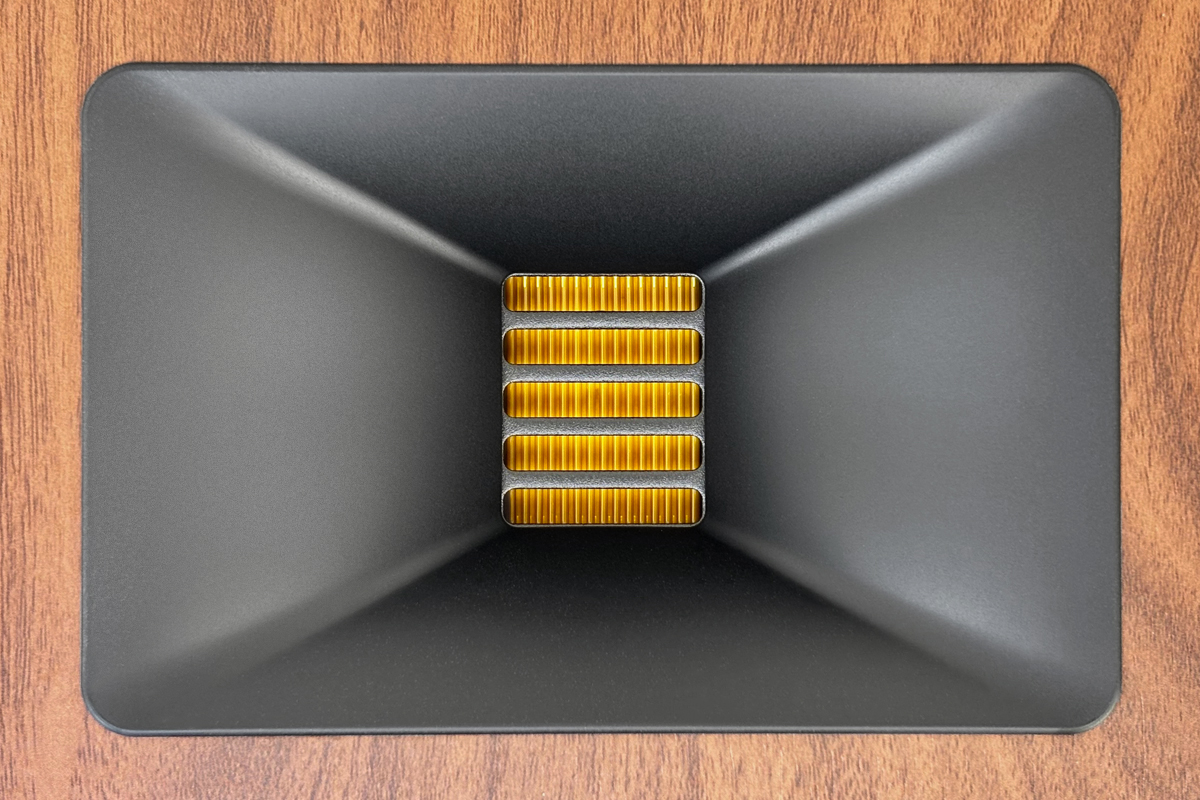I must admit that, prior to this review, I had no experience with Fluance’s products. This is surprising, given that Fluance has been in business for over 25 years and is a Canadian company based in Ontario—where I lived for over a decade. Despite my ignorance, Fluance has become a recognized hi-fi brand, thanks to its well-regarded loudspeaker and turntable products.
Fluance distinguishes itself through a commitment to delivering high performance at accessible price points. It sells direct to consumers in the US and Canada, and also through Amazon.
Part of the company’s Reference series, the Ri71 powered bookshelf speaker system is attractive and versatile, designed for music lovers and home-theater enthusiasts seeking quality sound without complexity. Positioned above Fluance’s more entry-level powered speakers (including the slightly larger Ai61 bookshelf model), the Ri71 leverages advanced features and materials typically found in higher-end speakers, including curve-sided, veneer-wrapped MDF cabinets. The driver complement comprises a waveguided 1″ Air Motion Transformer (AMT) tweeter and a 5.25″ woven-glass-fiber midrange-woofer. Inside one of the enclosures is a 60Wpc class-D amp that powers both speakers. The system sells for US$399.99 or CA$559.99.
Description
The Fluance Ri71 system is available in three finishes: white, black ash, and walnut—the color of my review sample. Each enclosure measures 12.2″H × 7.3″W × 7.8″D. The primary speaker (which the manual refers to as the “active speaker”) connects to AC power and contains the input and output connections as well as the amplifier that powers both speakers. By default, the primary speaker plays right-channel content, but this setting can be changed. It receives commands from the IR remote and provides feedback to the user via an LED that’s neatly mounted below the tweeter inside the rectangular waveguide. It feeds the secondary speaker (left channel by default)—which is a conventional passive box—via standard speaker binding posts.
Fluance supplies a 2.5m (8.2′) stripped, tinned speaker wire to carry speaker-level audio from the primary to the secondary speaker. This included cable is very thin, and Fluance recommends using at least 18-gauge wire if you need a longer span between the two speakers.
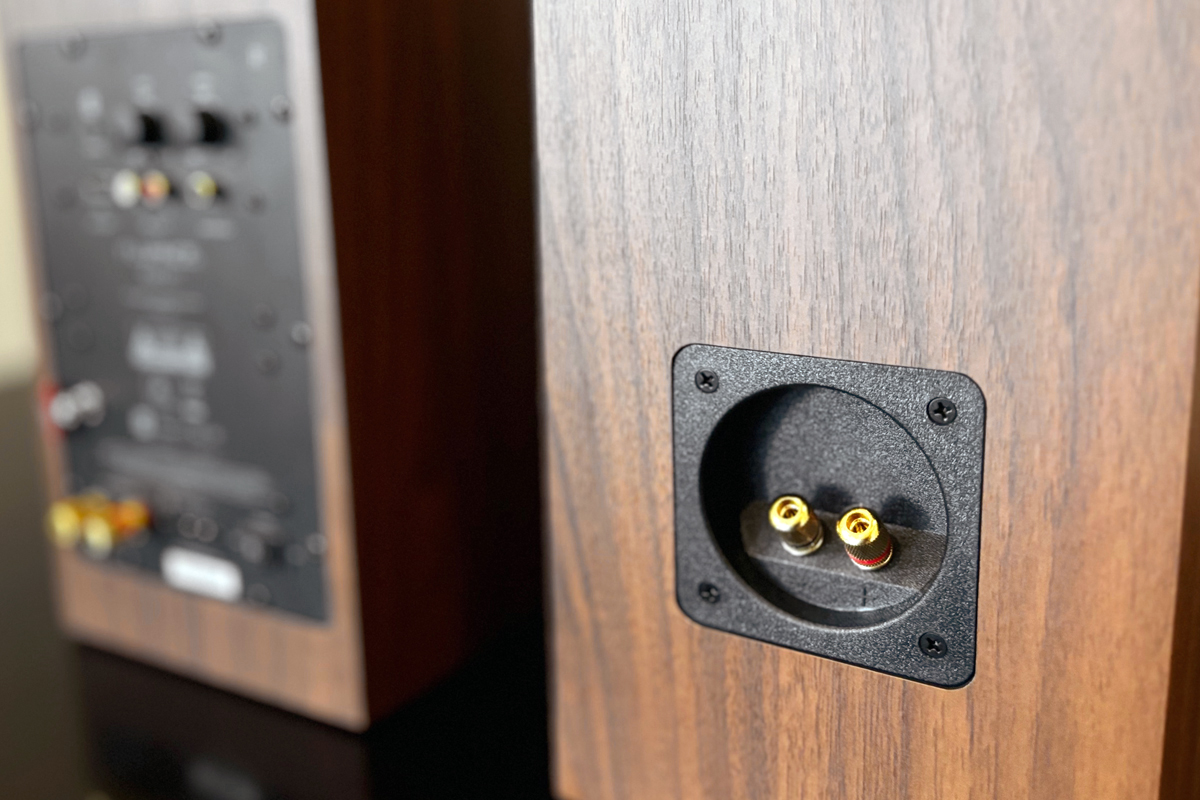
In terms of connectivity, the Ri71 is pretty basic, lacking USB, Wi-Fi, and ethernet functionality. Your input options are limited to Bluetooth (with support for the aptX HD codec), unbalanced analog using RCAs (line-level only; you’ll need an external phono preamp to play vinyl), or HDMI ARC for TV integration. It’s surprising to see an HDMI ARC input but no optical or USB digital input, given that these are available on the lower-tier Ai-series models. Ordinarily, features get added as you move up the range, not removed! The Ri71 does, however, retain the line-level subwoofer output using an RCA connector. This feature set suggests that Fluance is positioning this product as an alternative to soundbars for a TV-sound upgrade, rather than as a traditional hi-fi component system.
It’s worth pointing out that powered speaker systems like this are essentially a halfway house between traditional passive speakers and true active systems, which feature crossovers that come before the amplifiers in the signal path and dedicated amplifiers for each frequency range. The main benefit of the simple powered approach we have here is that the amplifiers can be perfectly matched to the attached speakers, while allowing the designer to bake in frequency-shaping equalization to optimize the overall system response and perhaps also limit the amplifier’s output to protect the speakers from over-excursion. Passive crossovers are still employed, so the system is still prone to the signal losses and other design challenges that accompany this traditional approach. Of course, building the amp into one of the speakers also means less component clutter.
My main concern with this style of powered system is that while the left and right enclosures are of the same external dimensions, one of them houses a bunch of electronics that the other one doesn’t have. This means a disparity in the internal air volumes, so the acoustic properties—including the bass-reflex tuning—of the left and right speakers will differ. For a stereo system, this is not ideal!
Unboxing the pair, this discrepancy between the two speakers was further underscored by the weight disparity: 14.1 pounds for the primary speaker, 11 pounds for the secondary speaker. I was also a little surprised to see front-firing slot ports employed for the bass-reflex alignment—an approach that’s been largely avoided among high-end speakers in favor of rear-firing tubular ports, to circumvent audible port “chuffing” caused by air turbulence. On the other hand, front-firing ports allow more flexibility in placement, as you can place the speakers closer to the front wall; this is the exact reason Fluance offers for their design choice.
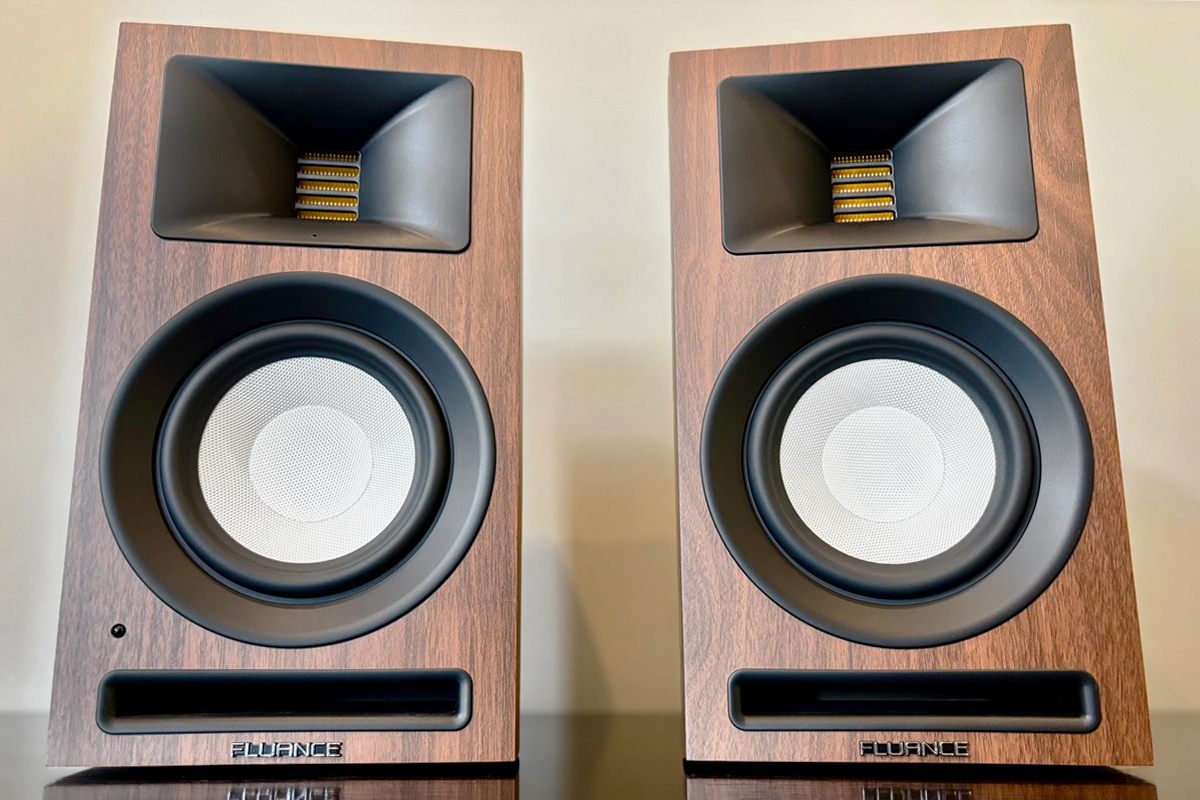
Unlike traditional dome tweeters, the AMT drivers used here employ a pleated, lightweight diaphragm to move air efficiently, with a purported improvement in transient response. A key advantage of the Ri71 system’s AMT tweeters is their integration with a custom-engineered waveguide to improve off-axis dispersion, theoretically widening the sweet spot. The waveguide also positions the transducer behind the speaker’s baffle, allowing better time-alignment with the acoustic source of the midrange-woofer. In designs with passive crossovers, physical positioning is the only way to time-align the output of multiple transducers, so the design seen here offers several benefits.
The combination of the white, woven-glass-fiber midrange-woofer driver cones and the copper-colored AMT tweeter diaphragms makes for a distinctive appearance, but be aware there are no grilles included if you’re not on board with this look—or if you want to protect those components from curious fingers.
Setup
Connection is incredibly straightforward, to the point where a printed user manual seems unnecessary. You connect the speakers using the included speaker wire between the two sets of decent-quality, color-coded binding posts, then plug the primary speaker into an AC power outlet with the included two-prong cable. Then, depending on your application, you can connect to an unbalanced, line-level analog source, a TV via HDMI ARC, or wirelessly via Bluetooth. Bluetooth pairing is initiated either using the dedicated pairing button on the back of the primary speaker or by holding play/pause on the remote, which worked effortlessly for me.
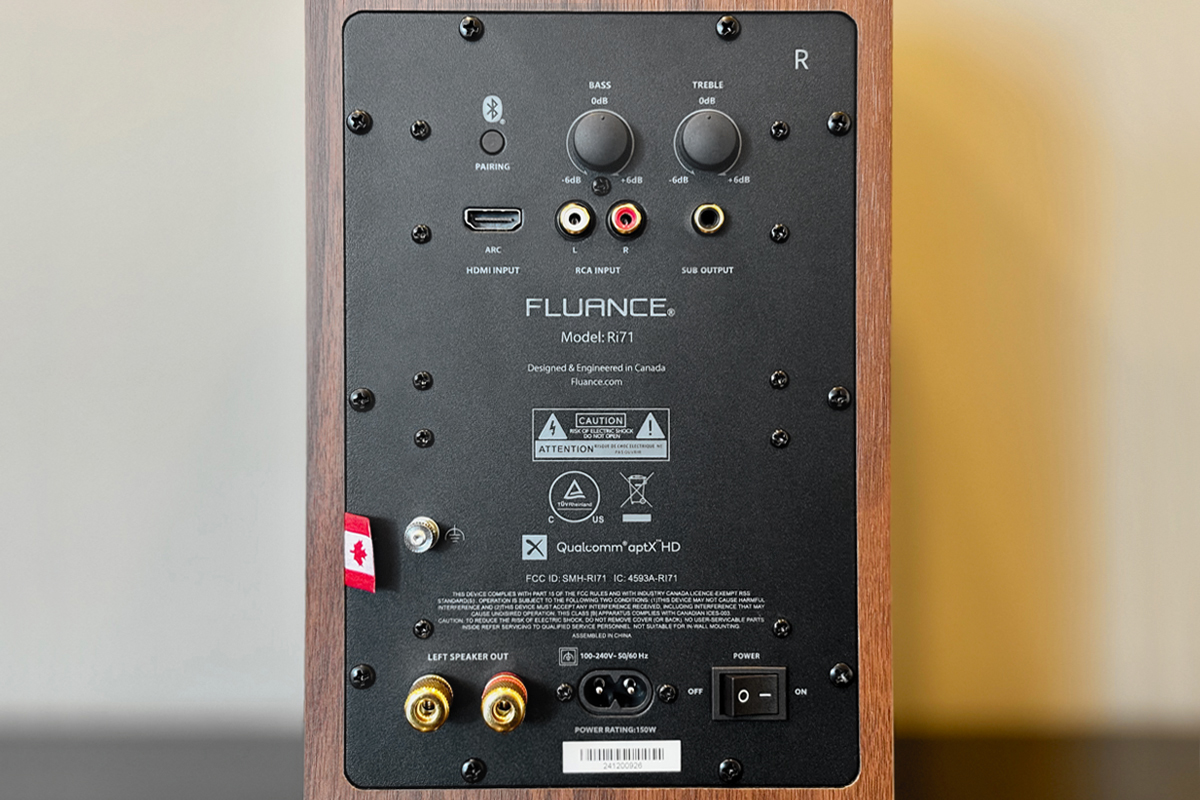
Given these input options, and the lack of either optical or USB connectivity, it should be apparent that the only way to feed uncompressed digital audio to the speakers is via HDMI ARC. Note, though, that if you connect a digital audio source such as a laptop with an HDMI output directly to the HDMI port on the Fluance Ri71, the laptop will not recognize the speakers as an output device, and no audio will be passed.
To get digital audio into the speakers, the HDMI’s Audio Return Channel (ARC) must be utilized, which means looping external sources through a recent-model TV with its HDMI ARC port connected to the Ri71. But when I did this with my XGIMI digital projector, I found that the output level produced by the speakers was barely usable, even with the volume controls on the projector and speaker system set to maximum. I had no issues with volume level when using Bluetooth or the analog input, which I came to rely upon for most of my testing. This did mean, however, that this testing involved an unnecessary D-to-A conversion from my source that was then converted back to digital inside the speakers for DSP enhancement.
The system offers only the most rudimentary controls for tweaking the sound: bass and treble knobs on the back of the primary speaker with a range of ±6dB. Fluance provides no information about the affected frequencies. These controls are mirrored on the rather basic remote control, and I mean literally mirrored, since there they appear (atypically) with the treble control on the left and bass on the right. This makes the remote’s user interface unintuitive, especially if you’re making adjustments in the dark.
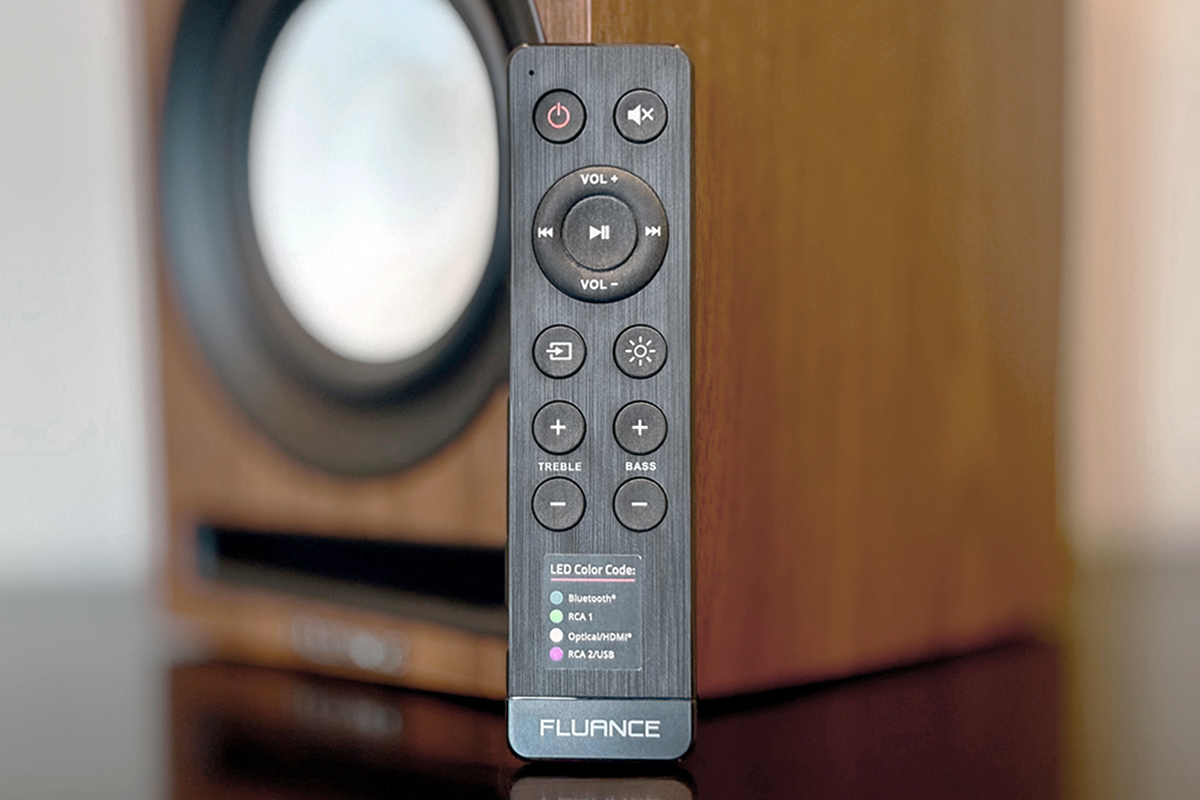
The remote allows you to step through the three available inputs, while the indicator LED on the front of the primary speaker provides color-coded feedback confirming your selection; this can be dimmed or turned off. The remote comes adorned with a sticker that explains these colors, but unhelpfully indicates there’s a fourth input option (RCA 2/USB) that doesn’t actually exist on this model. Even though Bluetooth is supported, there is no companion app, so what you see is what you get—there are no further tuning adjustments available, and no possibility of any firmware upgrades.
Volume control and input selection are also handled by a large, knurled knob inset on the top-rear edge of the primary speaker. The knob has a reasonably solid feel and provides a positive response when making adjustments, thanks to the detented rotary control. It also has a push-to-select function to step through input modes, although it’s a bit less intuitive when you consider that you generally operate it when facing the front of the speaker, which means pulling it towards you.
To complete the system’s connectivity options, there’s a line-level, mono subwoofer output on an RCA jack on the primary speaker’s rear panel. This has a clever feature where it will detect that an active subwoofer is connected and then automatically high-pass the signal the speakers are fed internally, with a corner frequency of 80Hz.
This worked reliably when I connected my Rythmik Audio subwoofer, offloading the low frequencies and effectively giving the Fluance system more headroom. There are no controls associated with this subwoofer output—not even a level control—and I found that I needed to apply some gain at the subwoofer’s end to get enough level for an appropriate-sounding balance.
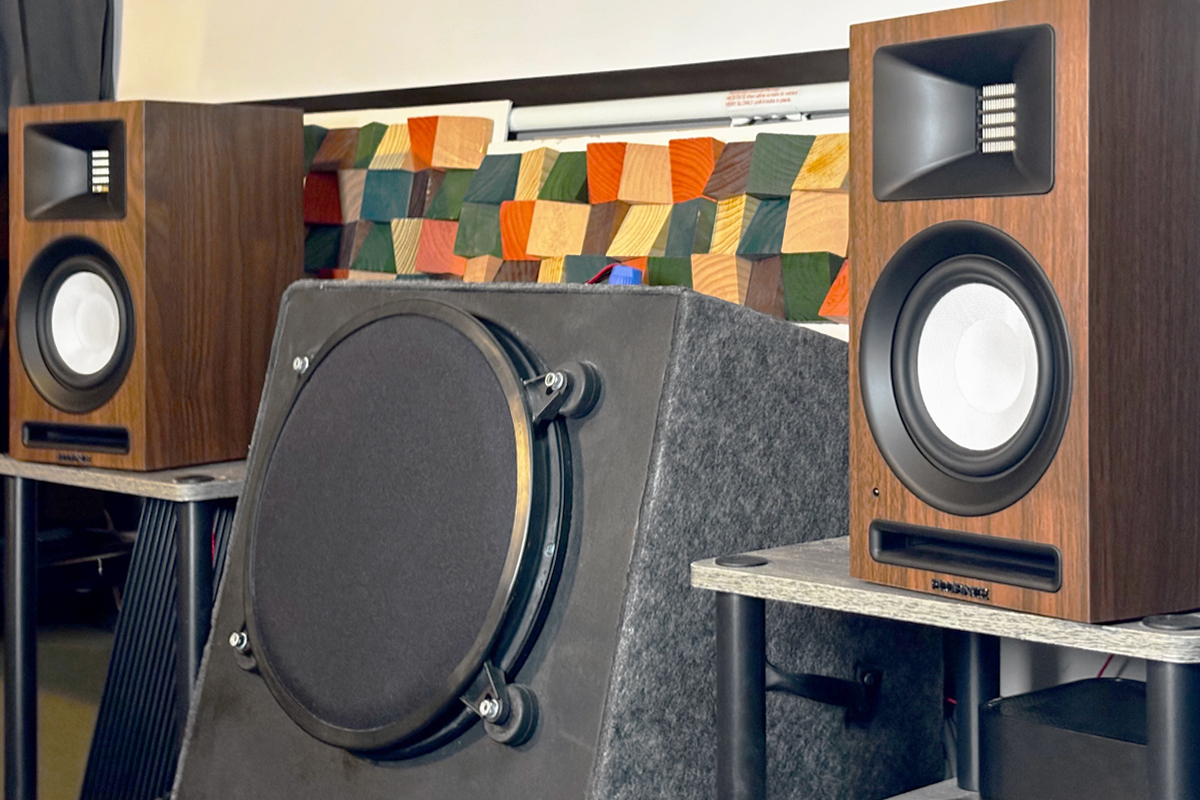
Lastly, the thing you do need the manual to tell you: if you want to swap the left and right designations of the primary and secondary speakers, you’ll need to hold the mute button on the remote for three seconds. Having a dedicated physical switch on the rear panel for this would have been preferable, since it would preclude the need for running tests to confirm which speaker is which!
The sound
For my listening tests I used my iPhone or my laptop through the AudioQuest DragonFly Black v1.5 DAC to feed the Fluance Ri71 system’s analog RCA input jacks (see above for an explanation of the input limitations I encountered). I began my listening in my larger 16′ × 9′ living space, which also connects to the main hallway of my apartment. Mounted on stands approximately 5′ apart, the Ri71 system produced a warm sound with articulate highs. I wasn’t particularly convinced by the bass response, though, and tried repositioning the speakers and experimenting with the limited tone controls. I concluded that augmentation using the subwoofer output would be necessary. Adding my Rythmik Audio sub to the system helped matters enormously.
However, I didn’t feel that reviewing the system augmented with a subwoofer would provide a lot of value, and opted instead to try the speakers by themselves in my 11′ × 8′ acoustically treated den, this time on a pair of equipment racks placed around 3.5′ apart (pictured). There the system sounded better, with a solidity to the bass that had been missing in the larger space. The low end was tightly controlled and punchier, making the overall sound far more satisfying while retaining the crisp top end I had heard before. Clarity and bass impact continued to impress after the 10-to-12-hour break-in period Fluance recommends.
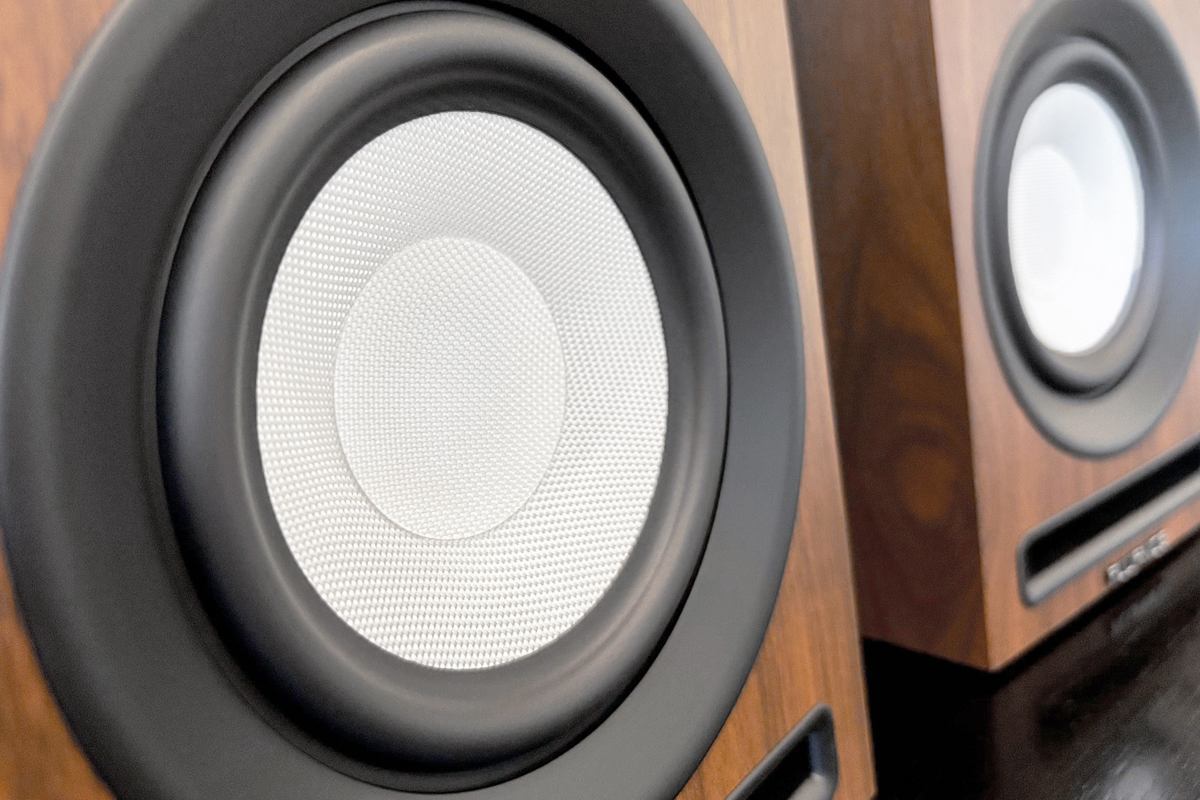
Before we dig into the notes and observations from my critical listening, I’ll first address the design concern I raised above regarding the internal volume discrepancy between the two speakers. Using a mono pink-noise sample that I panned back and forth between the left and right channels—without any diagnostic tools—I was easily able to discern a deeper tonal balance from the secondary speaker, confirming my suspicion that it has a larger acoustic volume and therefore a different tuning than the primary speaker. As I said, this is not ideal for a stereo system. I was also able to excite the port tuning using low-frequency tones and could hear the chuffing sound associated with turbulence originating from the front-firing slot ports. This is harder to identify in the context of most commercial music, but something to consider if bass clarity is important to you.
The woven-glass-fiber woofers deliver a solid low-end performance that doesn’t get near the deepest sub-bass frequencies, but they do a commendable job for speakers of this stature (even ignoring the price). The AMT tweeters provide airy highs and deliver excellent stereo imaging, helping the Ri71 create an expansive soundstage that appears larger than the cabinet size would suggest. Sitting with my ears at the height of the tweeters I found soundstage and imaging to be wide and authentic, offering an immersive stereo experience that would wipe the floor with most of the soundbars I’ve heard. The Ri71 system maintained its composure even at higher volumes, though with some harshness and loss of clarity at the highest settings.
The Postal Service’s “Such Great Heights (Remastered)” from Give Up (Deluxe 10th Anniversary Edition) (24-bit/44.1kHz FLAC, Sub Pop Records / Qobuz) features a distinctive blend of electronic and organic instrumentation. The track is built upon a foundation of synthesized textures, with layers of electronic drum rhythms, pulsing bass, and a variety of percussive synths that created a dense soundscape when played through the Ri71. The arrangement features a persistent “motorik” beat—steady eighth-note kicks and minimal snares—evoking the sensation of movement and endlessness, reminiscent of Kraftwerk.
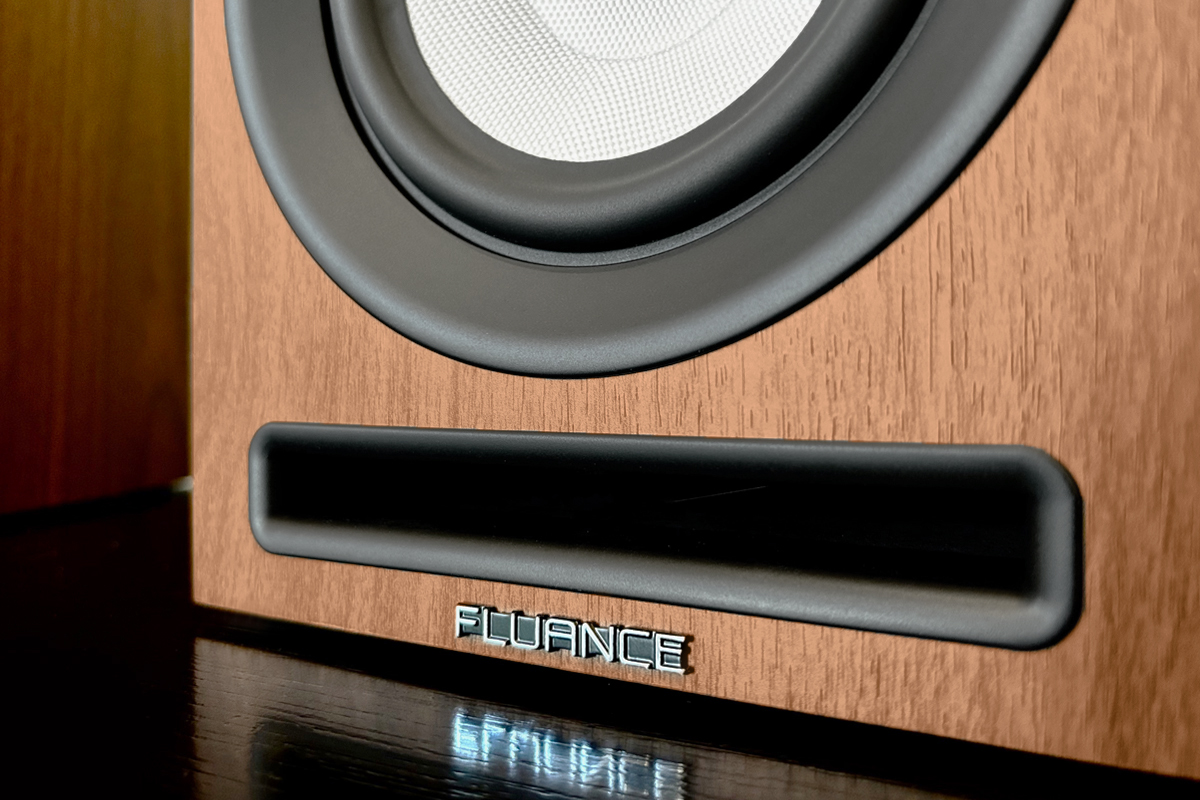
The track opens with a pattern of ear-catching, sharp transients as the sound rapidly switches between the left and right channels, which perfectly showcased the abilities of the Ri71’s AMT tweeters in both speed and imaging. The rhythmic drive is complemented by melodic synth lines and subtle piano layers. Ben Gibbard’s vocals and Jen Wood’s backing harmonies provide warmth and emotional depth, contrasting with the mechanical precision of the electronic elements like the scratchy percussion flittering between the left and right extremes.
The song’s arrangement is carefully constructed to create dynamic shifts in texture and space. Throughout, elements are added and removed to maintain interest and build toward the chorus, which features a pulsing bass part that was solidly presented by the Fluance’s midrange-woofers, tightly controlled by the onboard class-D amps. The Postal Service creates a block of sound with clean, clear vocal parts, leaving intentional gaps in the mix for sporadic percussive sounds to emerge. The song felt both lush and spacious through the Ri71, with a sense of forward momentum that mirrored the lyrical themes of longing and connection across distance.
“Buzzcut Season” from Lorde’s Pure Heroine (24/192 FLAC, Universal Records / Qobuz) blends electropop with subtle tropical influences and deep bass parts, which the Ri71 again handled with a tight grip. The track’s distinctive instrumentation is anchored by crisp percussive snaps and a prominent xylophone motif, creating a shimmering, almost aquatic texture. The xylophone lends the song a delicate, dreamlike quality that complements Lorde’s introspective lyrics. This choice of instrumentation, combined with understated electronic elements, gives the track a sense of both intimacy and expansiveness. The song opens with sparse instrumentation, gradually layering in additional elements such as piano and subtle synths as it progresses. This gradual build allows the emotional weight of the lyrics to take center stage, with vocal layers cleanly rendered with great separation, while the instrumental layers provide a lush yet uncluttered backdrop.
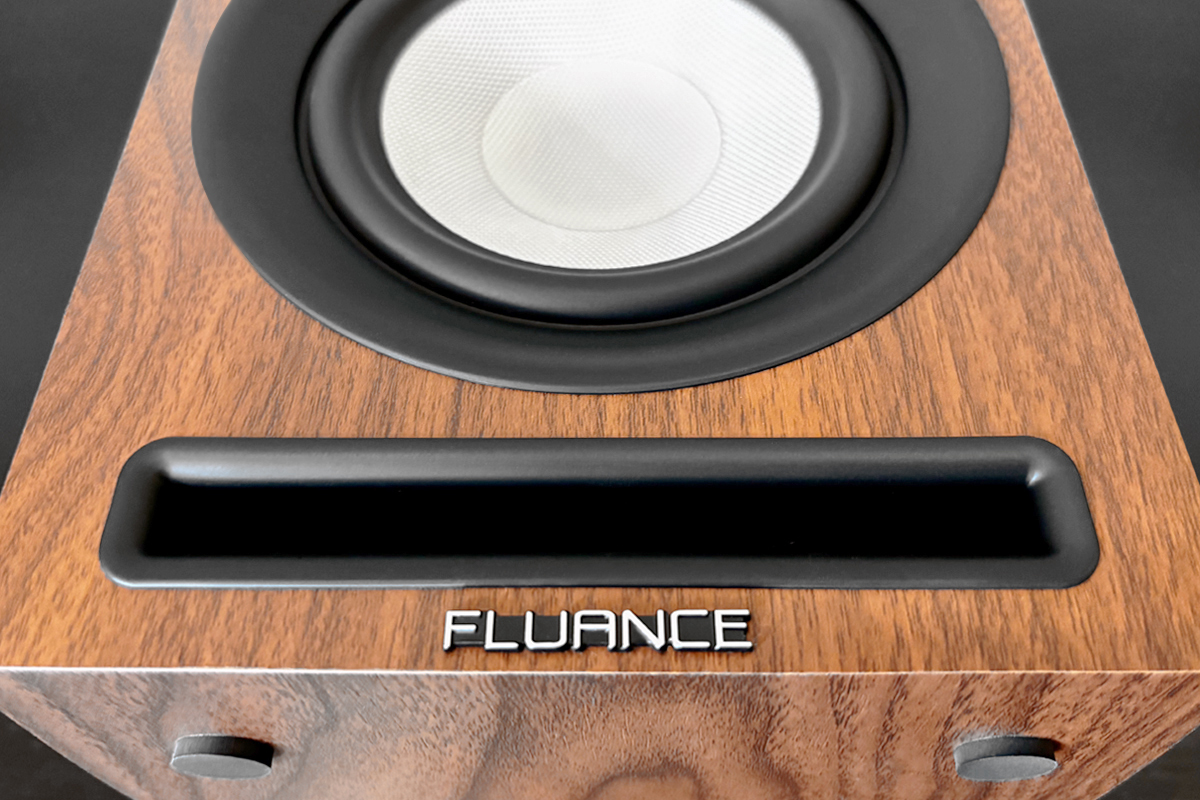
Producer Joel Little’s mix is clean, each instrument occupying its own space, which allowed the intricate interplay between the percussive snaps, xylophone, and synths to shine through the Ri71 with clarity and precision. Reverb and delay effects, applied sparingly but effectively during production, contributed to the system’s ability to reproduce the song’s ethereal atmosphere without overwhelming the core elements. The production’s subtlety ensures that Lorde’s vocals remain front and center, capturing the vulnerability and nuance in her delivery. This approach results in a track that feels both modern and timeless, balancing electronic polish with organic warmth, served up admirably by the Fluance system.
Comparison
For comparison, my old Tannoy PBM 5II passive monitors are appropriately specified, with similarly proportioned, ported two-way bookshelf-sized enclosures and 5″ midrange-woofers. The Tannoys were driven by an Aiyima A07, fed by a WiiM Mini that applied a gentle EQ curve that I’d preset based on my own subjective tuning of those specific speakers. Since the Fluance speakers have their own tuning baked in, I reasoned it made sense to keep my tuning for the Tannoys enabled. I arranged them alongside the Fluance speakers on my equipment racks, then matched levels between the two sets using a ‑20dBFS pink-noise sample, measured at the listening position using the NIOSH SLM app on my iPhone, to yield 75dBA.
Despite the physical similarities between the two sets of speakers, I was immediately struck by the clear tonal-balance differences. I found that the Fluance speakers sounded very forward in the lower midrange, having a tubbier, fuller sound. This made the Tannoys sound mid-scooped in comparison, punching lower and deeper, with a brighter, more present top end.
The song “21st Century” by Red Hot Chili Peppers, from their album Stadium Arcadium (2014 Remaster) (24/192 FLAC, Warner Records / Qobuz), showcases the band’s signature blend of funk, rock, and experimental elements in its instrumentation. The track features Flea’s dynamic bass lines, which drive the groove with a punchy, syncopated rhythm, while Chad Smith’s drumming provides a tight, energetic backbone. I loved the drum sounds on both systems, finding that the rhythm section sounded full-bodied but flatter on the Fluance speakers, and comparatively livelier and punchier on the Tannoys.
As the track progresses, the arrangement builds in intensity, with each instrument taking turns in the spotlight. The structure avoids excessive layering, instead opting for clarity and space, which allows the individual performances to shine. The mix sounded clean and punchy on both systems, with each instrument occupying its own space in the sonic landscape.
John Frusciante’s guitar work stands out for its combination of funky riffs and expressive solos, adding grit and melodic flair to the song. The instrumentation is further enriched by subtle layers of additional percussion that contribute to the track’s rhythmic complexity and its depth of stereo field, which was presented differently by the two sets of speakers. The brighter top end of the Tannoys gave a slightly wider spread to the soundstage, whereas the Fluance speakers provided a more cohesive center image, with Anthony Kiedis’s lead vocals extending more tangibly forward into the room, and a deeper soundstage to the overall production.
Conclusion
Fluance’s Ri71 Reference powered bookshelf speaker system offers a compelling blend of decently engineered sound and a functional, no-nonsense design at a price that makes high-fidelity audio accessible to a wider audience. While there are some design compromises, it excels as a stereo system for music, a TV-sound upgrade, or a multipurpose setup for modern living spaces. If Wi-Fi connectivity or a built-in phono stage aren’t on your must-have feature list, the Ri71’s performance and value are hard to beat in this segment.
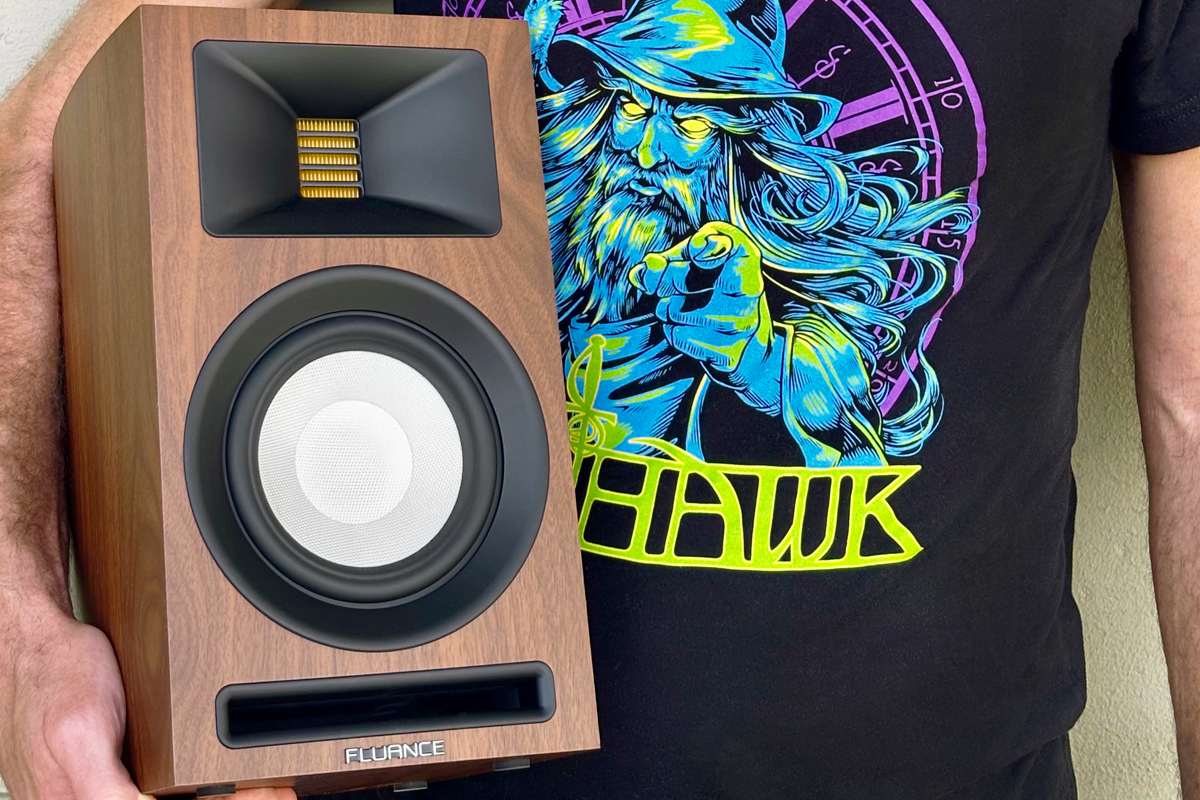
While some competitors may offer deeper bass or more power, I was happy with the Ri71’s overall balance when used in smaller spaces like my 11′ × 8′ den. AMT tweeter technology is rare at this price, giving the Ri71 an edge in high-frequency detail and spatial presentation compared to many rivals using conventional tweeters. The sound should appeal to both casual listeners and budding audiophiles.
I found a couple of minor rough edges to the user experience, and in particular found the lack of an S/PDIF input baffling. I unfortunately didn’t have access to alternative hardware to find out if the low volume level over HDMI ARC is a consistent issue. But with those caveats in mind, it’s fair to say that the Fluance Ri71 is a great stereo speaker set for its price, and anyone considering a soundbar to enhance their TV experience ought to listen to this system first.
. . . AJ Wykes
Associated Equipment
- Laptop: Apple MacBook Pro (2019)
- Sources: iPhone 15, WiiM Mini
- DACs: AudioQuest DragonFly Black v1.5, Schiit Modi
- Speakers: Tannoy PBM 5II
- Power amplifier: Aiyima A07
- Subwoofer: Rythmik Audio 12″ Direct Servo
- Display: XGIMI Horizon Pro XK03H Smart 4K portable projector
Fluance Ri71 Reference powered loudspeaker system
Price: US$399.99, CA$559.99
Warranty: Two years, parts and labor
Fluance
4080 Montrose Road
Niagara Falls, ON L2H 1J9
Canada
Fluance
840 Aero Drive
Cheektowaga, NY 14225
Phone: 1-888-617-6863
Website: www.fluance.com





